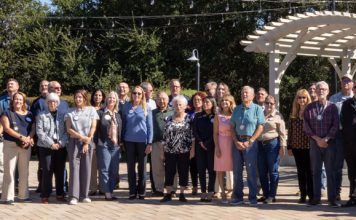Chuck Reed relaxed on home-building plans for area development,
says jobs should come first
Morgan Hill – San Jose Mayor-elect Chuck Reed said he will neither “stall” nor “rush” Coyote Valley development.
But as the four-year-old planning process for 25,000 homes and an estimated 50,000 jobs north of Morgan Hill and west of U.S. 101 lumbers forward, some planning participants have observed a loss of momentum, stirring doubt over how effective and long-lasting the Coyote Valley Specific Plan could be when its finished next year.
Five weeks after defeating San Jose Vice Mayor Cindy Chavez in the mayoral race – in which Chavez campaigned she’d be open to allowing homes before jobs in Coyote Valley, as long as it didn’t financially hurt San Jose – Reed is sticking to his guns that jobs should come first.
But nobody knows how long that could take, or if companies will locate to an area devoid of urban services.
As it stands, San Jose’s general plan calls for 5,000 office building permits to be issued before housing developments can move forward in the 7,000-acre industrial reserve that was established 40 years ago. For now, Reed wants to keep it that way.
“I support the triggers that are in place now,” said Reed, who’s been watching Coyote Valley’s cloudy destiny unfold for 25 years, since he was appointed to the San Jose Planning Commission in 1982. “They should not be changed unless we have a citywide general plan committee to determine what changes should be made.”
Lo and behold, that’s something expected to start next summer and take two years as San Jose reviews its general plan. Reed, who co-chaired the last general plan update committee in 1992 and 1993, said it’s unclear now how that process will affect Coyote Valley’s pace of development.
But few expected Coyote Valley to turn overnight into an 80,000-person suburb, geographically as big as Mountain View.
To that end, Santa Clara County Supervisor Don Gage thinks the 20-member Coyote Valley Task Force, of which he’s a member, may be moving too aggressively – even though it is at least six months behind schedule. The task force was appointed in August 2002 by San Jose’s City Council after out-going Mayor Ron Gonzales was lobbied by home builders to get a plan done.
“The whole process has moved along so quickly,” Gage said. “I think they could have taken more time … The problem is, there are a lot of issues relating to county roads and water that could be addressed in the Environmental Impact Report, but we haven’t seen that yet.”
An EIR, required by state law to address and mitigate significant environmental consequences of a development, was scheduled for an October release but is now expected in March 2007. The final version of all plans for the direction of a Coyote Valley community could before the San Jose City Council at the end of next year.
But that doesn’t mean developers – who’ve paid more than $18 million so far for the Coyote Valley planning process – will be building in early 2008.
In addition to reviewing economic triggers for some 25,000 housing units, regional issues such as traffic effects on the cities of Morgan Hill and Gilroy may warrant a closer look.
Chris Platten, a member of the San Jose Planning Commission and an appointed member of the task force, said Reed’s election as mayor won’t by itself slow Coyote Valley plans – but other factors such as money could weigh things down.
“I’m looking forward to discussing the financial details more,” said Platten, a San Jose labor attorney.
Gage said San Jose’s concept of a more urban North First Street-type neighborhood with 30,000 homes and 27-million-square feet of office space suggests that Coyote Valley development has lost some steam.
“There’s a lot of industrial and commercial space (for jobs) in downtown San Jose and they’re talking about building 30,000 homes there,” Gage said. San Jose approved the concept in 2005. “That’s as big as Coyote Valley. I don’t know how San Jose could support both.”












